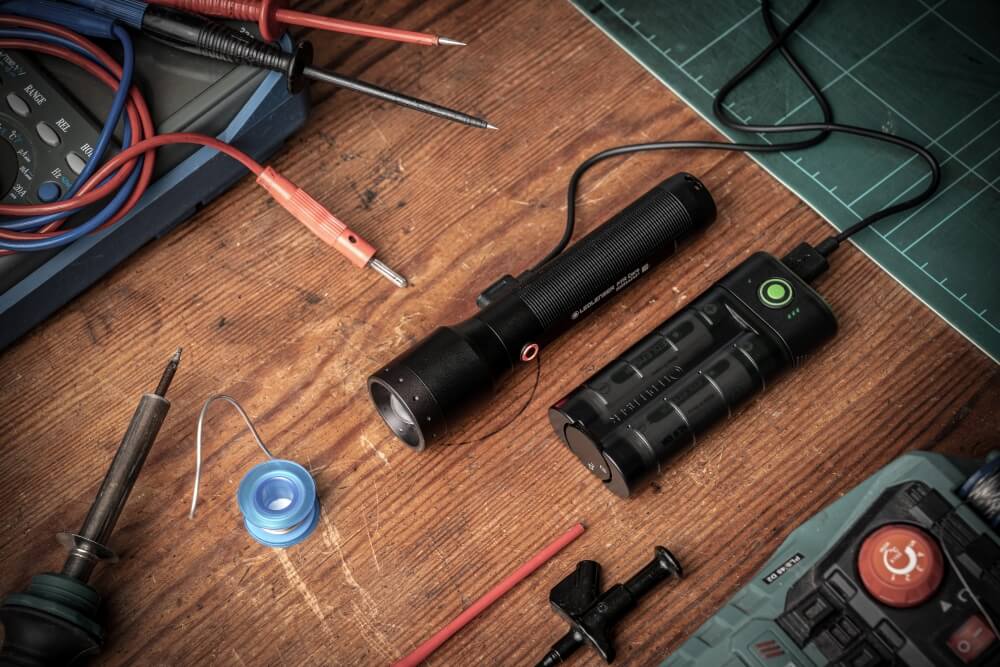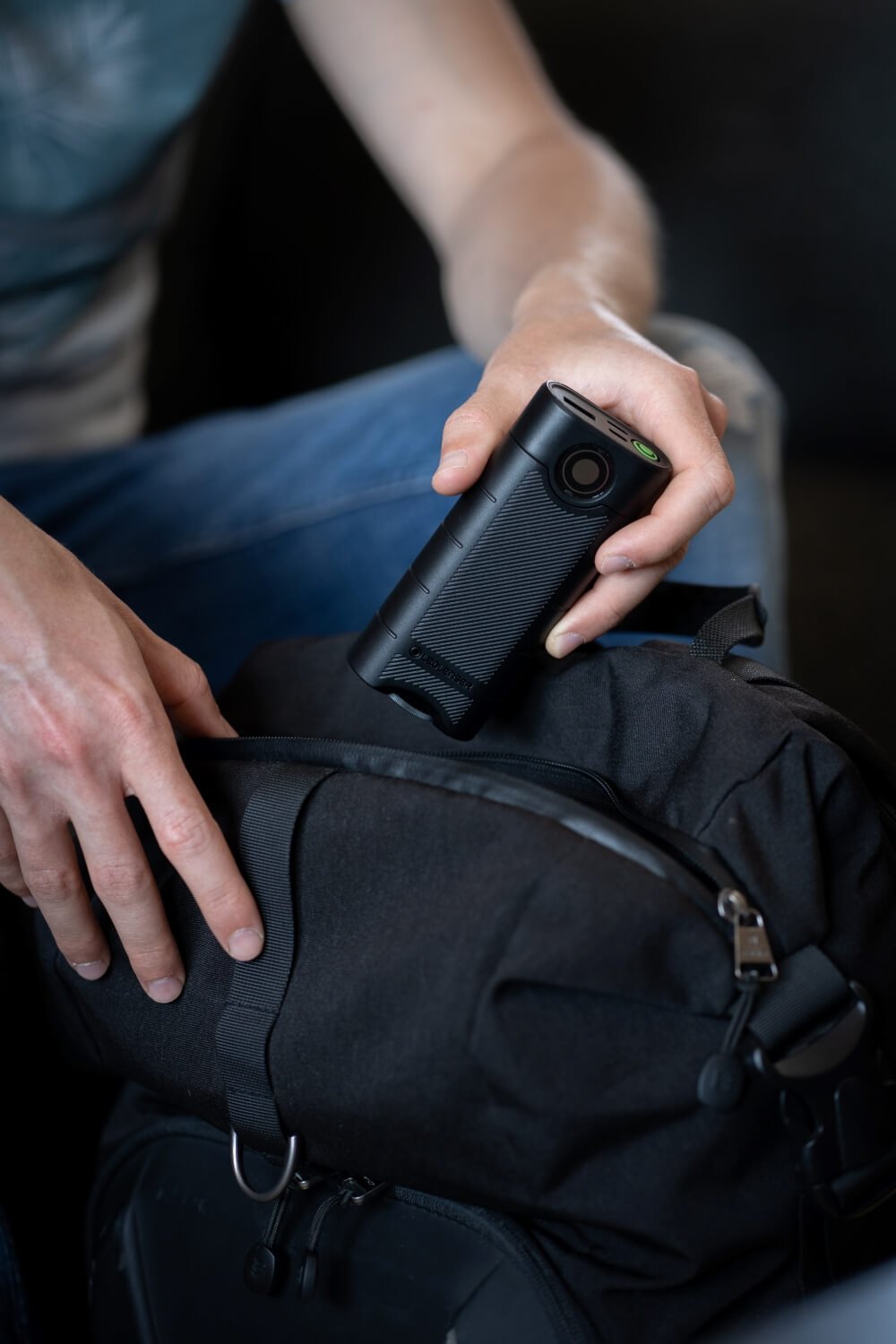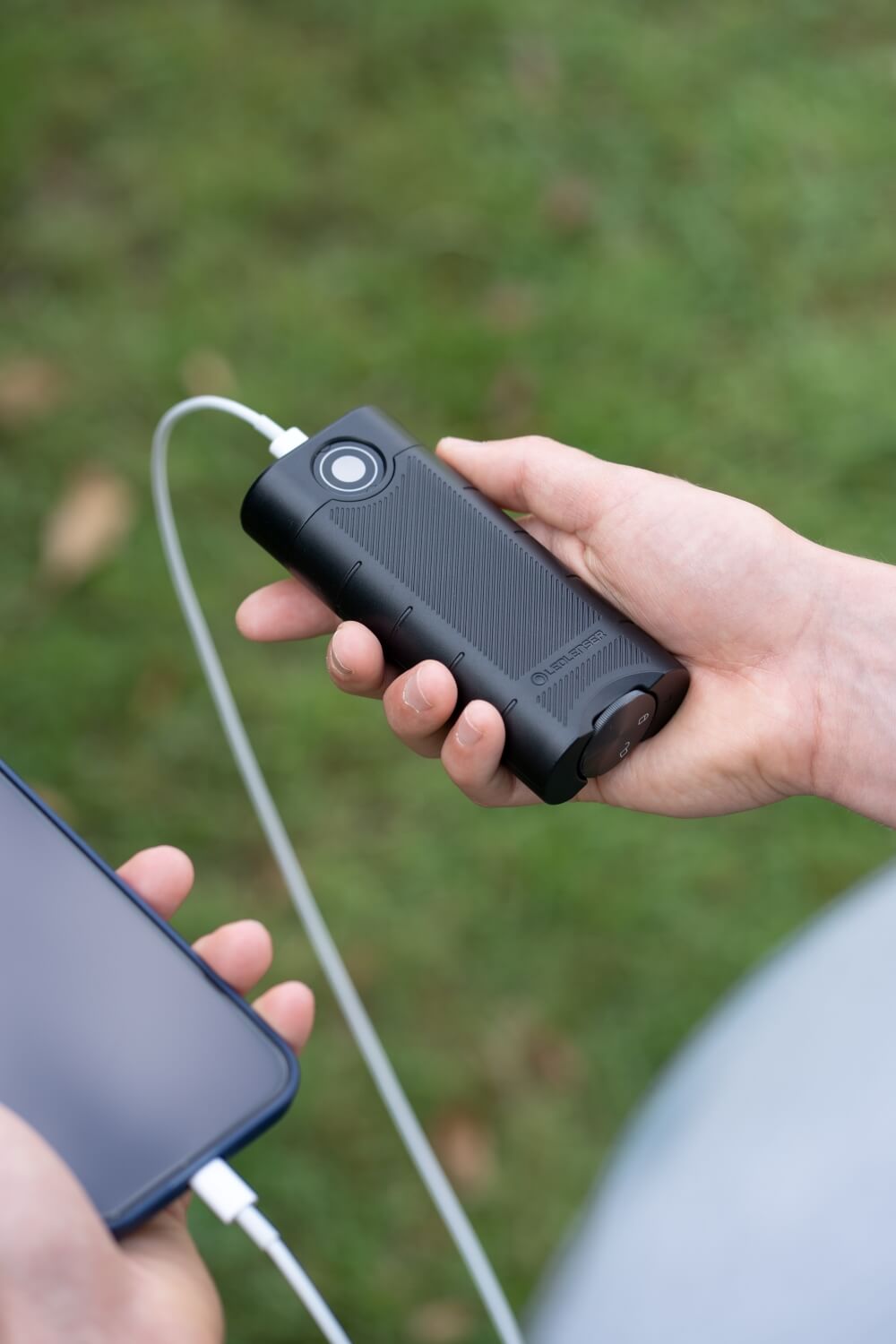A power bank is a portable charger that stores electrical energy. This energy can then be used to charge mobile devices.

What is a power bank?
A power bank is a type of portable charger. It was specially developed to supply electronic devices such as smartphones, tablets or cameras with power. These mobile energy storage devices give you the freedom to access a reliable power source anywhere and at any time.
Power banks are particularly useful when you're out and about, for activities such as hiking, camping or long train journeys. They allow you to remain independent of stationary power sources and keep your devices ready for use at all times.
Inside a power bank are battery cells that store electricity and release it to your devices when needed. Power banks are particularly practical when traveling, during outdoor activities or simply as an emergency reserve in everyday life. Modern power banks often have several USB ports so that you can charge several devices at the same time. There are also models with fast-charging functions that speed up the charging process.
Powerbanks come in different sizes and capacities. Smaller models fit easily in your pocket and provide enough power for one or two smartphone charges. Larger power banks have a higher capacity and are suitable for longer trips or for charging several devices at the same time.

How does a power bank work?
Inside a power bank are lithium-ion or lithium-polymer batteries that store electrical energy. This energy is transferred to your device via a USB cable as soon as you connect it.
The power bank itself is charged via a socket using an adapter and a USB cable. This works in a similar way to charging a cell phone. The charging process begins when you connect the power bank to a power source. The current flows into the battery cells of the power bank and is stored there. As soon as the power bank is fully charged, you can disconnect it from the power source and use it for your mobile devices as required.
Many modern power banks offer multiple connections so that you can charge different devices. There are also models with fast charging functions that significantly reduce the charging time of your devices. Most power banks also have integrated protection mechanisms against overcharging, overheating and short circuits, which makes them particularly safe to use.
Powerbank - What should you look out for?
When buying a power bank, several factors play an important role in making the right choice. Here are the most important aspects you should consider when looking for the best power bank:
Capacity
The capacity of a power bank is given in milliampere hours (mAh). A higher capacity means that the power bank can store more energy and you can charge your devices more often. A power bank capacity of 3,000 to 10,000 mAh is sufficient for smartphones. A normal cell phone battery has around 2,500 mAh to 4,000 mAh.
Size & weight
Compact and lightweight power banks are ideal for on the go, as they fit easily in your pocket and don't add any extra weight. Larger models offer more capacity but are less handy.
Connections
Pay attention to the number and type of ports. USB-A, USB-C and Micro-USB are common connections. Multiple ports allow you to charge several devices at the same time. Power banks with USB-C ports often offer faster charging times.
Charge level indicator
A charge level indicator informs you about the remaining energy in the power bank. Models with LED displays or digital displays offer a more precise overview.
Robustness and IP class
If you want to use your power bank for outdoor activities, make sure it has a robust design and a high IP rating. This rating indicates how well the power bank is protected against dust and water.

What is so special about Ledlenser power banks?
The market for power banks has become very large. In addition to well-known manufacturers, there are also many dealers on the market who sell power banks of inferior quality. At Ledlenser, quality, robustness and your safety are our top priorities. Ledlenser power banks are characterized by a variety of unique features.
- Outdoor suitability: With IP65 water and dust protection, the power banks are ideal for outdoor use. They are splash-proof and therefore robust enough for adverse conditions.
- Replaceable batteries: The power banks use replaceable batteries (21700 or 18650). These batteries can be removed and inserted into compatible Ledlenser lamps. If a battery is defective, it can simply be replaced without having to dispose of the entire power bank. This reduces electrical waste and protects the environment.
- Double short-circuit protection: The power banks not only serve as a transport box for rechargeable batteries, but also offer double protection against short circuits. Both the supplied rechargeable batteries and the power banks are protected accordingly.
- Charge level indicator and low current function: The power banks have a charge level indicator that allows you to check the battery status at any time. They also have a low current function, which enables the charging of very small devices with a very low charging current.
- 7-year warranty: If you register online within 12 weeks of purchase, you will receive a five-year warranty from us in addition to the two-year statutory warranty. This covers the replacement or repair of your power bank.
- USB-C connections: The Flex5 and Flex10 models use USB-C connections. These offer numerous advantages such as faster charging times and greater compatibility with modern devices. USB-C is a future-proof standard that can be plugged in on both sides, making it easier to use.
Note: USB-C as the standard in the EU
From 2024, USB-C will be uniformly introduced as the standard for chargers in the EU. This will reduce electronic waste and simplify the charging of devices. This law affects all mobile devices such as smartphones, tablets and cameras.
Powerbanks from Ledlenser
Ledlenser offers four power banks. These are all waterproof and dustproof and have a charge level indicator. You can find all other features in the table:
|
Feature |
Flex3 |
Flex5 |
Flex7 |
Flex10 |
|
Dimensions (L x W x H in mm) |
109 x 27 x 27 |
103 x 41 x 28 |
109 x 47 x 27 |
120 x 54 x 29 |
|
Weight with battery (g) |
88 |
126 |
164 |
235 |
|
Weight without battery (g) |
40 |
55 |
116 |
164 |
|
Battery type |
1x 18650 Li-ion battery, 3.6V |
1x 21700 Li-ion battery, 3.7V |
2x 18650 Li-ion battery, 3.6V |
2x 21700 Li-ion battery, 3.7V |
|
Battery capacity |
12,34 Wh / 3400 mAh |
16,65 Wh / 4500 mAh |
24,68 Wh / 6800 mAh |
33,30 Wh / 9000 mAh |
|
IP class |
IP65 |
IP65 |
IP65 |
IP65 |
|
Rechargeable |
Yes |
Yes |
Yes |
Yes |
|
Charging time (min) |
240 |
140 |
240 |
240 |
|
Energy status display |
Battery indicator, charge level indicator, low battery warning |
Battery indicator, charge level indicator, low battery warning |
Battery indicator, charge level indicator, low battery warning |
Battery indicator, charge level indicator, low battery warning |
|
USB-C |
No |
Yes |
No |
Yes |
Conclusion: This is why power banks are useful
Powerbanks offer a reliable way of supplying mobile devices with energy on the go and help to ensure that you are always available and your devices remain ready for use. Powerbanks are particularly useful when you are on the move and traveling.
Models such as those from Ledlenser impress with their high quality, replaceable batteries and special protective functions, making them a durable and sustainable choice. With the best power bank, you are ideally equipped to access a mobile power source anytime and anywhere.
What is a power bank - frequently asked questions and answers
A power bank is needed to charge mobile devices on the go. It is particularly useful when there is no power socket available.
Most power banks are compatible with all cell phones as long as the connectors fit. If you have the right cable, this shouldn't be a problem.
A power bank is very useful for traveling and when you are out and about. It provides a reliable power source when no power socket is available.
A power bank acts as a mobile charger for various devices. It stores electrical energy and releases it when needed.
A good power bank has sufficient capacity and several connections. Models such as the Ledlenser power banks also offer additional protective functions.
You can charge a power bank using a USB cable. Simply connect it to a socket using a cable and an adapter.





